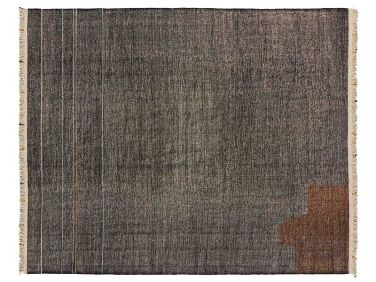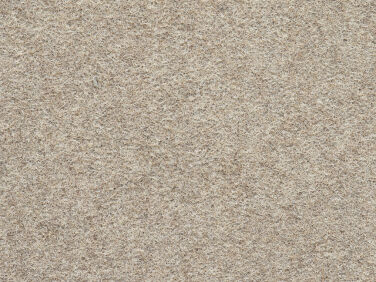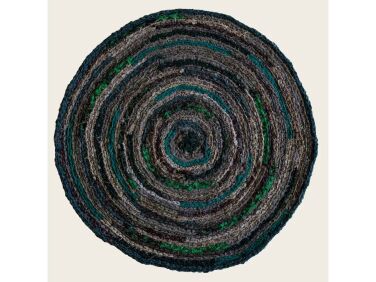Where to begin when searching for eco-friendly, ethically-made household rugs: floor coverings that are beautiful, durable, made of renewable materials, and aboveboard in every way? For advice we turned to Catherine Connolly, CEO of Merida, a company specializing in natural fiber, zero-synthetic rugs that is helping to revive the weaving industry in the old Massachusetts mill town of Fall River. Some of Merida’s designs are also made in India by workshops that are Goodweave-certified, ensuring that weavers are fairly paid and that materials are of the best quality. And all have received Green Product Assurance (GPA), intensive third-party testing for quality and safety.
Here are Catherine’s answers to our many questions.

What are the essentials to know when browsing for rugs?
For anyone committed to low-impact living, there are three factors to consider when assessing a rug: 1. The impact to the environment 2. The impact on human health and well-being. 3. The impact on the people who made it. A rug made from natural materials that are sustainably sourced is a good choice for the planet and for respiratory health.
What are some rug materials that are notably eco friendly?
Look for rugs that are woven from rapidly renewable natural materials: the ideal are eco-friendly natural fibers that look and feel like the original source, such as wool, mohair, alpaca, or sustainably sourced plant fibers like linen, sisal, jute, and abaca. A shocking 90 percent of rugs on the market today are made of nylon or polypropolene (PP). Even many so-called “natural” rugs are blends containing a high percentage of synthetics, which become harmful as they break down and are released into the atmosphere over time—like many paints, offending rugs have high levels of VOC emissions. If you can’t trace the provenance of all the materials in the rug, you don’t really know what you’re bringing home.

Materials to steer clear of?
Nylon, plastics, and other synthetic fibers have a damaging impact on the environment in terms of the resources they extract and how they’re processed. Synthetic rugs are generally less expensive, but the price we pay in terms of impact to the environment and respiratory health is incalculable. In addition, all synthetic yarns have to be treated with toxic fire retardants because petroleum is highly flammable. Natural fibers are naturally fire resistant, so they don’t require chemical treatments that have been shown to be detrimental to human and environmental health.
What are some details to look for?
Look for the tightness of the construction, the natural sheen of the yarns, and the integrity of the backing. The best answer to low-impact living is to buy high-quality products that are naturally durable and will delight you for years to come: buy once and buy well.

Which natural materials are hardwearing and which ones are short-lived (even if biodegradable)?
Natural yarns are inherently durable. Wool and silk are virtually indestructible, and naturally stain resistant. Antique rugs woven from wool and silk have lasted for centuries. Plant fibers like sisal and jute are also very durable but shorter-lived than animal fibers; a well-made sisal rug will peak after a decade or so, whereas a high-quality wool rug should last for generations. The construction of a rug and how the yarns are spun also impacts performance: the tighter the construction, the more durable the rug. All of these factors should be taken into consideration when choosing which rug is best for high-traffic areas versus going barefoot in the bedroom.
What’s an okay underside?
If there’s a backing, it should be made of eco-friendly latex and glue. Many mass-market backings contain toxic chemicals: check with the manufacturer for a list of materials. We also always recommend a rug pad for the longevity and care of the rug as well as for safety to keep people from slipping if it’s an area rug. We use natural latex rug pads that we cut to match our rugs.

Is it possible to know if the rug makers were fairly treated and paid for their work?
If the rug was made in a country where labor regulation is not consistently enforced—India, Nepal, Pakistan, Bangladesh, for instance—look for third-party verified certifications, such as GoodWeave, SA 8000, and RugMark, that set guardrails against child labor and advocate for safe working conditions and fair wages. When sizing up a rug, it’s important to consider the hands that made it.
Any other certifications to look for?
Green Product Assurance is another good one—they test every component involved in the rug making process and screen all for toxic chemicals. It’s a big, ongoing commitment for a company to earn GPA certification—other programs are less rigorous (and less expensive).
Are all-wool, naturally dyed rugs compostable?
If the dyes used are mostly organic, with just trace amounts of chemicals, an all-wool rug is compostable, as long as it’s shredded or cut into small pieces. Otherwise even a biodegradable rug takes decades to decompose in nature.

How common is it to find naturally dyed rugs?
It’s extremely rare to find rugs with natural, all-organic dyes. Most rugs on the market are colored with chemical dyes thanks to their reliability, consistency, and accessibility. And that applies even to rugs made by small producers in remote areas. We partner with a dyer who specializes in organic dyes that contain only trace amounts of chemicals, not enough to even register in third-party testing.
Do certain rugs help regulate temperature and acoustics?
I’m sure all rugs help with sound absorption, but wool is known to be the absolute best and the thicker the pile the better. When it comes to temperature control—keeping rooms warm in winter and cool in summer—wool is also known to be the best, not only for insulation but also for its ability to extract some of the moisture/humidity from the air.

There are so many choices; any parting advice?
After more than 15 years in this business, my overwhelming thought is that the most important reason to buy natural rugs is for the beauty and pleasure that they bring to the room. They have so many qualities that truly change the experience of a space, including sound absorption, temperature control but also the tactile experience. It would be hard to overemphasize these points; we all spend so much of our lives surrounded by plastic textiles that we don’t know what we are missing in the beauty and pleasure category.
Peruse the Remodelista archive for more Expert Advice, including:
- Expert Advice: 10 Eco Best Practices for Home Building and Remodeling Projects
- Expert Advice: The Art of Wallpaper and How to Incorporate It
- How to Paint Kitchen Cabinets: 5 Tips from a Master Painter
Frequently asked questions
What is an eco-friendly rug?
An eco-friendly rug is one that is made from sustainable materials using environmentally friendly processes and practices.
What materials are used to make eco-friendly rugs?
Materials used to make eco-friendly rugs include natural fibers such as wool, jute, sisal, and hemp; as well as recycled materials such as plastic bottles and old clothing.
How can I find out if a rug is ethically made?
Look for rugs that are certified by organizations such as GoodWeave or the Global Organic Textile Standard (GOTS), which ensure that the rug was made without the use of child labor and under fair labor conditions.
Are handmade rugs more ethically made than machine-made rugs?
Not necessarily. Both handmade and machine-made rugs can be made ethically or unethically. It's important to look for certification and research the brand's practices to determine whether a rug is ethically made.
Are eco-friendly rugs more expensive than traditional rugs?
Not necessarily. While some eco-friendly rugs may be more expensive due to the use of higher quality materials and labor practices, others may be comparable in price to traditional rugs.
How do I care for my eco-friendly rug?
Caring for an eco-friendly rug is similar to caring for a traditional rug. Vacuum regularly, spot clean as needed, and have the rug professionally cleaned when necessary.










Have a Question or Comment About This Post?
Join the conversation